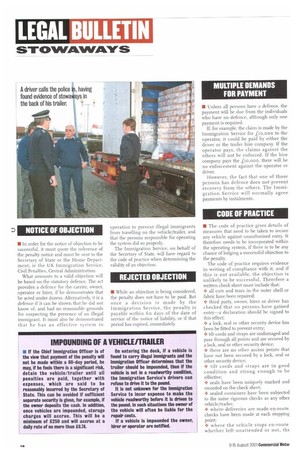CODE OF PRACTICE
Page 18

Page 19

If you've noticed an error in this article please click here to report it so we can fix it.
• The code of practice gives details of measures that need to be taken to secure any vehicle against unauthorised entry. It therefore needs to be incorporated within the operating system, if there is to be any chance of lodging a successful objection to the penalty.
The code of practice requires evidence in writing of compliance with it, and if this is not available, the objection is unlikely to be successful. Therefore a written check sheet must include that; • all cuts and tears in the outer shell or fabric have been repaired;
4. third party, owner, hirer or driver has checked that no persons have gained entry—a declaration should be signed to this effect;
• a lock, seal or other security device has been be fitted to prevent entry; • tilt cords and straps are undamaged and pass through all points and are secured by a lock, seal or other security device;
4* there are no other access points that have not been secured by a lock, seal or other security device; 0. tilt cords and straps are in good condition and strong enough to be effective;
+ seals have been uniquely marked and recorded on the check sheet; • sealed containers have been subjected to the same rigorous checks as any other vehicle/trailer; • where deliveries are made en-route, checks have been made at each stopping point; + where the vehicle stops en-route whether left unattended or not, thE checking procedure has been repeated and documented as above;
+ if alternative arrangements, such as the use of a security firm, have to be made they must be equally effective.
PRIOR TO BOARDING THE SHIP THE SYSTEM SHOULD INCORPORATE CHECKS: + of tilt cords and straps for evidence of tampering, damage or repair; + on seals, locks or other security devices to ensure they have not been removed, damaged or replaced; + to ensure unique markings remain intact; + on the outer shell/fabric for signs of damage or entry; + on the roof which needs particular attention. Drivers are advised to park
away from tankers or buildings that could be used by illegal immigrants to climb on to the roof of the vehicle or trailer; + of external storage compartments, toolboxes and wind deflectors, as well as under the vehicle to ensure there are no illegal immigrants hiding on the vehicle; • that other methods for security and detection provided by the owner/operator or hirer are used;
+ inside the vehicle.
Notes and records of all checks must be recorded in writing as proof of compliance with the code of practice, and these must be made available to the Immigration Service immediately upon being stopped.
• There is no oral hearing. The driver or operator is not entitled to see Immigration Service evidence, such as witness statements. All they can rely on is his written submission of objection and any documentary evidence he provides.
On the face of it, the procedure does seem to breach the Human Rights Act, but the courts have indicated that there is an appeal procedure. There has been a recent decision by the High Court indicating that the Secretary of State would seem to be the sole arbitrator of the question of a valid defence, and as such he would be acting as judge in his own court.
The case concluded that the operator could, however, wait until the Secretary of State sued in the Civil Court before raising its defence. In this way there is an appeal process. The defendant operator would have to establish that he was not liable to a penalty because he acted under duress or had an effective system for preventing the carriage of clandestine immigrants, which was in place and that there was no failure in his system.
The court also pointed out that until the penalty was due, the vehicle impounded could not be sold. This seems, in effect, to mean that until the civil case has been concluded, a vehicle that has been impounded cannot be sold.
• If the operator or driver, or anyone, turns a blind eye to the presence of illegal immigrants on their vehicle/trailer, this could have far more serious consequences. It is not simply a question of a penalty, there will also be a criminal prosecution.
Any person who knowingly carries out or makes arrangements for securing or facilitating the entry to the UK of anyone who he knows to be, or has reasonable




























































































































